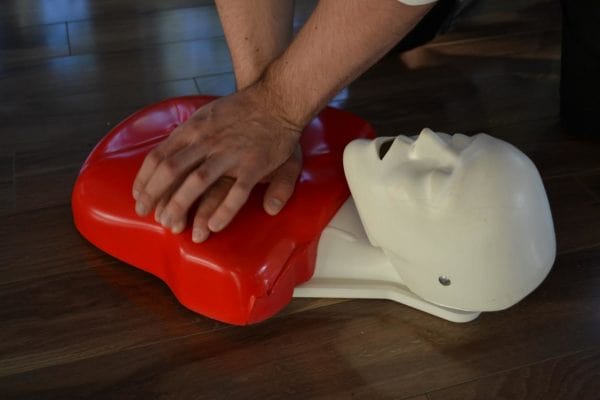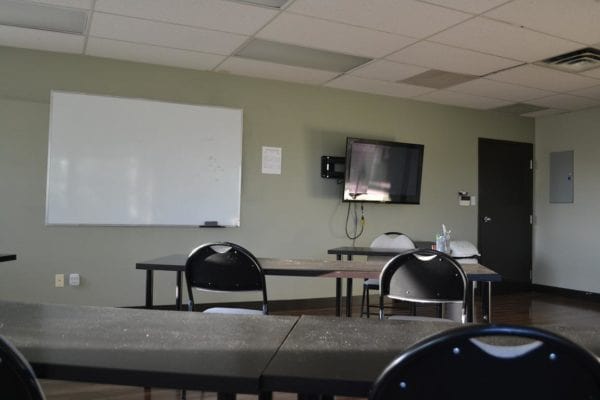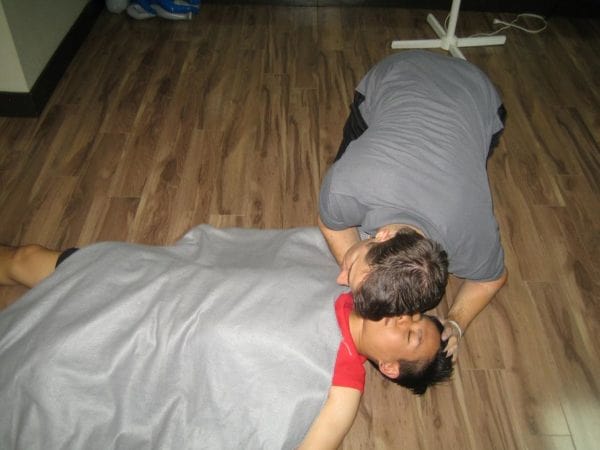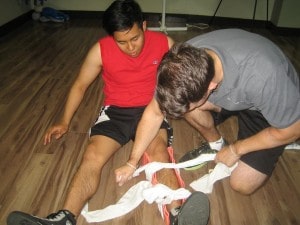CPR Only Training
Are you looking to learn only CPR techniques and don’t want any training in first aid? St Mark James Training offers cardiopulmonary resuscitation (CPR) and automated external defibrillator (AED) programs for individuals needing only CPR and AED training. This programs meet CPR standards for workplace and academic requirements. Candidates that complete these half / full day programs receive a CPR certificate that is valid throughout Canada for 3 years. Learn more by selecting one of the options below.

Register for a Course
We offer a range of different training programs to help you get prepared for a number of emergencies. All of our training providers offer extremely competitive prices and offer amazing teaching facilities and teachers. Candidates will receive training manuals and awards upon completion of the course. Register today to learn the skills to save a life.

First Aid Training
Would you know what to do in a serious emergency? Would you be able to help someone if they were hurt, suffering a heart attack or suddenly fell unconscious? Canadian first aid and CPR training teaches effective and easy to learn techniques to individuals that want to learn to help. Two major first aid courses are available for Canadians that want to learn the basics in helping others. Standard first aid is a two day course that meets a number of workplace, academic and government certification standards. Emergency First Aid is a comprehensive one day course that also meets the same certification standards. Both classes include training in cardiopulmonary resuscitation (CPR) and the effective use of automated external defibrillators (AED).

In 2024, St. Mark James, Vancouver First Aid Ltd, the Heart and Stroke Foundation, and St. John Ambulance collectively updated their first aid and CPR programs—the most significant changes in over a decade. Each provider implemented these updates at different times throughout the year, affecting all levels of CPR training as well as both Standard and Emergency First Aid courses.
To stay up to date with the latest techniques and protocols, enroll in a hands-on first aid course with one of our trusted, workplace-approved training providers. All of our partnered providers are listed on our first aid and CPR location page.
CPR Changes

Since the 1970s, Cardiopulmonary Resuscitation (CPR) has followed the simple A-B-C approach—Airway, Breathing, and Circulation. However, in 2011, this standard was updated to C-A-B, prioritizing Chest Compressions first, followed by Airway and Breathing. While the meaning of each letter remains the same, greater emphasis is now placed on starting chest compressions as early as possible, significantly increasing the chances of survival.
Another key update in 2011 is that rescuers are now instructed to check for breathing first, then send a bystander to call EMS, ensuring that emergency responders receive critical information sooner. Additional refinements have also been made across CPR Level “A,” CPR Level “C,” and Health Care Provider (HCP) CPR to align with the latest life-saving protocols. In order to learn all the new CPR changes and to practice these skills take a first aid and CPR course.
CPR / Choking Procedure Changes
The 2024 CPR and first aid guidelines have introduced significant updates to the procedures for assisting choking victims. Instead of relying solely on J-Thrusts (formerly known as abdominal thrusts) for conscious victims with a complete airway obstruction, rescuers will now alternate between 5 J-Thrusts and 5 back blows.
This method was originally part of choking rescue protocols before 2001 but was removed for the past decade. However, based on recommendations from the International Liaison Committee on Resuscitation (ILCOR), this technique has been reintroduced. Studies have shown that alternating between back blows and J-Thrusts increases the success rate of clearing an obstruction, improving the chances of survival for choking victims.
First Aid Program Changes
Emergency First Aid
Emergency First Aid, now also known as basic first aid, has undergone the most drastic changes out of all the first aid and CPR courses. The course has come to include more material from the standard first aid course including more emphasis on the treatment of wounds and bleeding. Candidates will learn how to cater to a wider variety of different wounds involving deadly bleeding, amputations and other serious first aid bleeding situations.
Standard First Aid
The standard first aid curriculum remains largely unchanged, with the exception of updates to the wound care portion, which now aligns with the latest changes introduced in emergency first aid training. Given the comprehensive nature of standard first aid, adding additional material would require extending the course length.
To stay informed about the latest updates to standard or emergency first aid, enroll in a hands-on course with your local St Mark James Training Provider.
As new research and statistics continue to emerge, CPR and first aid guidelines will evolve to ensure the most effective and life-saving procedures. All major certifying organizations—including St Mark James Training, the Heart and Stroke Foundation, and St. John Ambulance—work in close coordination to update their protocols, ensuring consistent and up-to-date training for rescuers across Canada.
Candidates will learn the latest CPR techniques and guidelines as outlined in this video, which showcases the 2025 ILCOR standards for CPR and resuscitation on adult victims using a pocket mask. All of our certified training providers, listed on our locations page, incorporate these updated techniques into their courses, ensuring participants receive the most current and effective life-saving training.
